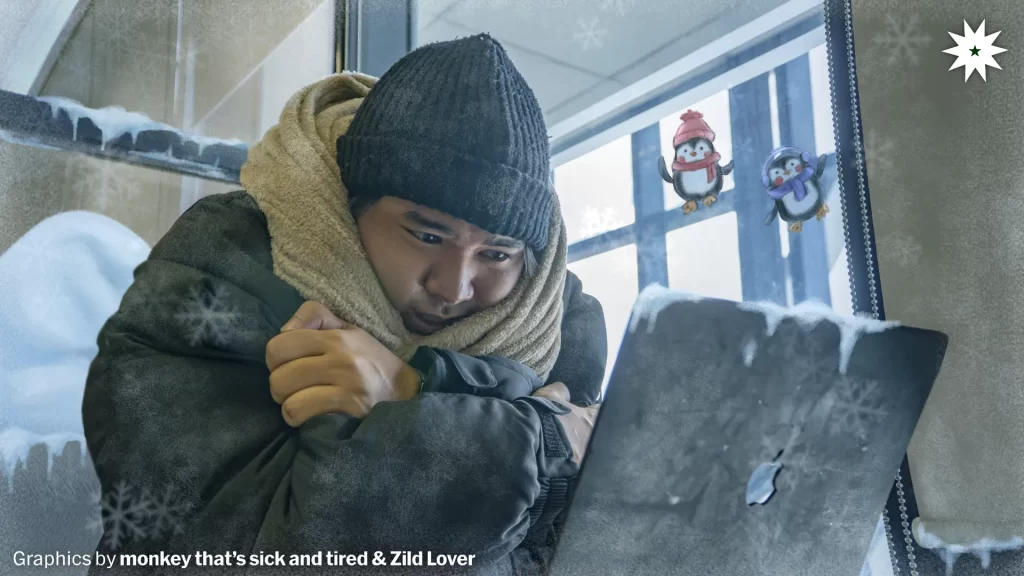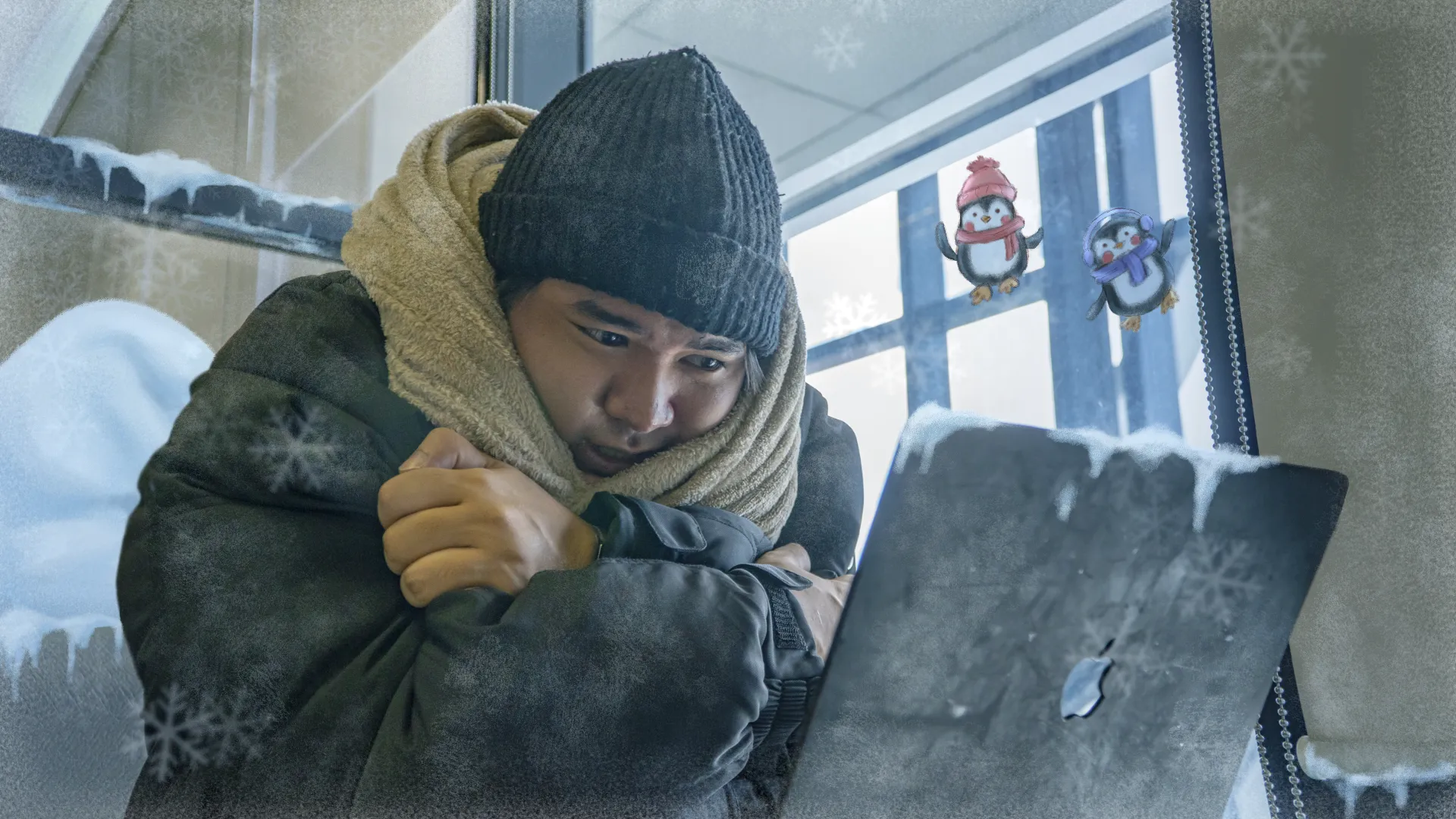Inside the Henry Sy Sr. Hall dwells the Manila Campus library also known as the Learning Commons. The designated study areas, spanning from the 6th to the 14th floors, are notorious for their wealth of educational resources but also infamous for their ruthless, subarctic climate. Upon entering these spaces, one would immediately notice Lasallians shivering with visible puffs of breath at every corner. With a half-frozen mind in the polar library, one may wonder if they are on the brink of hypothermia.

Arctic Academia in action
Alright, “hypothermia” might be a stretch. But there’s no denying one simple truth: the library is freakishly cold. This is likely the consequence of the University’s noble attempt to shield Lasallians from the relentless Philippine heat. While a touch of cold might seem refreshing, the library’s temperatures seem to have been calibrated by someone with an aversion to warmth. This excessive attempt at providing comfort has somehow transformed the scholastic landscape into a frozen tundra.
However distressing, Henry’s glacial temperature may also be intentional to preserve the University’s prized artifacts. After all, excessive warmth can spell doom for delicate documents, rare texts, and fragile antiquities. “We try to freeze them in time ‘cause they’re too important to just melt away,” explains librarian Lucius Best, justifying why the library feels like a cryochamber. Admirable? Absolutely. Practical? Only if you’re training students for an Arctic expedition.
Ice, Ice, Study
Despite the freezing atmosphere of the study area, the library remains a popular spot for students to review their notes, finish assignments, and, most reliably, chill in between classes. And chill they do, as clusters of students are frequently found huddled in corners, wrapped in layers of sweaters, blankets, and the occasional emergency thermal foil. Tales of frostbitten fingers whispered prayers for summer’s return, and students’ frozen mid-page turn have become part of standard Lasallian folklore.
Faced with this frozen frontier, students have developed their own survival strategies. Thick sweaters and woolen scarves are standard armor, while others resort to layering clothes so aggressively that they leave looking like laundry baskets with legs. Some opt to bypass the ordeal entirely, fleeing to warmer, less hostile corners of campus. After all, why brave Henry’s arctic blast when you can study somewhere that does not make your teeth chatter in protest?
Cold, hard truths
Staying in such an environment could trigger shivering and dying syndrome (SADS), a condition caused by reduced sunlight and cold, gloomy weather. SADS is characterized by having low energy levels, difficulty concentrating, and oversleeping. Jack Frost (VI, BSAD), a frequent resident of the hall, shared his experiences: “Knowing that I’m cooked for my exams already and I forgot my jacket makes me sad. But seeing all these gloomy students in Henry makes me even sadder.”
Moreover, the cold environment triggers the brain’s “energy-saving mode,” making individuals feel lazy and unmotivated. Being uncomfortably cold could also lead to spikes in cortisol, the stress hormone causing high irritability. Cold and dark environments also encourage people to keep to themselves, which can lead to feelings of loneliness, further impacting a person’s mental well-being.
Yet, during his time in the library, Frost witnessed an unexpected trend. “Narito tayo para mag-aral, bakit may mga nag-bebe time rito sa library? Sakop pa nila mga outlet at couches,” remarked Frost.
(We’re here to study. Why are there couples cuddling in the library? They even occupy the outlets and couches.)
However, some studies suggest that cooler temperatures actually enhance people’s focus and analytical thinking. “The cold never bothered me anyway. In fact, it makes me want to build something,” shared Elsa Parker (III, BSMEEMTE) when asked about the temperature’s effect on her condition.
All chilled out
Due to the polar climate of the Henry Sy Sr. Hall, many students migrate to warmer areas around the campus to study or gather. Gokongwei Study Hall, another popular hub for student conventions, is the go-to destination for those displaced by Henry’s cold temperatures. Miguel Cruz (III, BSMEEMTE) describes how conducive Gokongwei is compared to Henry for students: “I really like it here; the temperature is just right; there’s plenty of space for me; I could basically live here 24/6.”
Studies have shown that temperatures around 21 degrees Celsius are the sweet spot for productivity. If the temperature were to be colder or warmer, drowsiness or fatigue would set in. Dr. Bannila Aice, a professor of psychology at DLSU, explains the phenomenon with an analogy: “Parang aircon lang utak natin. Too cold, mamatay ‘yan bigla. Too hot at puputok din yan.” Aice firmly recommends a good balance between hot and cold to allow our brains and bodies to be at peak productivity and condition.
(Our brains are like air conditioners. Too cold and it’ll shut off. Too hot and it’ll explode.)
Finding the perfect place to study on campus is not an easy task. In the end, students may have to choose among the smelly and crowded confines of Gokongwei Study Hall, the peaks of Br. Andrew Gonzalez Hall, or the chilling climate of Henry Sy Sr. Hall.
This article was published in The LaSallian‘s Spoof 2025 issue. To read more, visit bit.ly/TLSSpoof2025.



